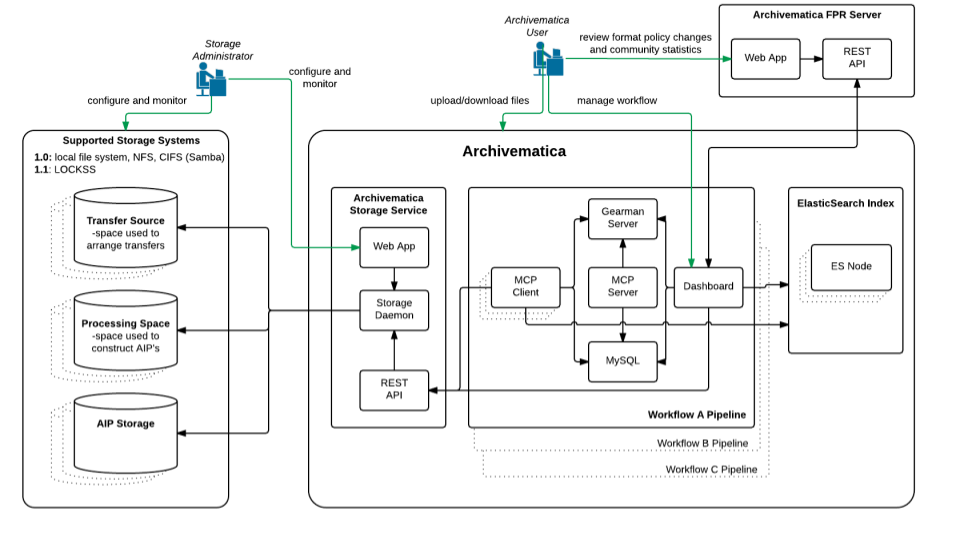Technical architecture¶
This page provides a high-level overview of Archivematica’s technical architecture.
Microservices design pattern¶
Archivematica implements a microservice approach to digital preservation. The Archivematica microservices are granular system tasks which operate on a conceptual entity that is equivalent to an OAIS information package: Submission Information Package (SIP), Archival Information Package (AIP), Dissemination Information Package (DIP). The physical structure of an information package will include files, checksums, logs, submission documentation, XML metadata, etc.
For more information, see Microservices.
External tools¶
Archivematica is built upon additional open-source frameworks and services.
For more information, see External tools.
Web-based dashboard¶
The web dashboard allow users to process, monitor, and control the Archivematica workflow processes. It is developed using the Python-based Django MVC framework. The Dashboard provides a multi-user interface that will report on the status of system events and make it simpler to control and trigger specific microservices. This interface allows users to easily add or edit metadata, coordinate AIP and DIP storage, and provide preservation planning information. Notifications include error reports, monitoring of MCP tasks, and manual approvals in the workflow.
For more information, see Web-based dashboard.
Format policies¶
Archivematica maintains the original format of all ingested files to support migration and emulation strategies. However, the primary preservation strategy is to normalize files to preservation and access formats upon ingest. Archivematica groups file formats into format policies (e.g. text, audio, video, raster image, vector image, etc.). Archivematica’s preservation formats must all be open standards. Additionally, the choice of formats is based on community best practices, availability of free and open-source normalization tools, and an analysis of the significant characteristics for each media type. The choice of access formats is based largely on the ubiquity of web-based viewers for the file format.
Since the 1.0 production release, Archivematica format policies have been moved to a structured, online format policy registry (FPR). The FPR brings together format identification information with significant characteristic analysis, risk assessments, and normalization tool information to arrive at default preservation format and access format policies for Archivematica.
For more information, see Preservation Planning.
From Transfer to SIP to AIP and DIP¶
The primary function of Archivematica is to process digital transfers (accessioned digital objects), turn them into SIPs, apply format policies, and create high-quality, repository-independent Archival Information Packages (AIP) using METS, PREMIS, and Bagit. Archivematica can be bundled with AtoM but is designed to upload Dissemination Information Packages (DIP), containing descriptive metadata and web-ready access copies, to any access system (e.g. DSpace, ContentDM, etc.).
Single install¶
Archivematica can be installed on one or many Linux-based operating systems, on a Virtual Machine or on dedicated hardware. The entire suite of digital preservation tools is available from one single installation. Archivematica’s client/server processing architecture allows it to be deployed in multi-node, distributed processing configurations to support large-scale, resource-intensive production environments.
For more information, see Installing Archivematica.



